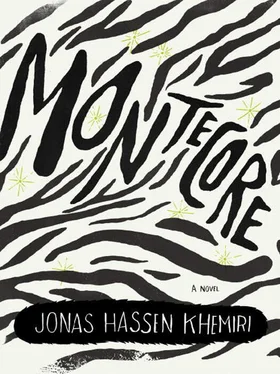And you must admitthat Kadir actually has a point because it is in the formulating of the rules of grammar that you see Swedish from the outside in for the first time. And maybe this is where your linguistic curiosity is wakened? Dads who decide that there is a system to language and ask for your help and what is bigger than dads who ask sons for help? The whole spring you go directly to the studio after school. You help with grammar, practice pronunciation, and correct their texts with dictionaries. You do your best to make up simplified rules of grammar, which Dads collect in the black wax notebook. And you remember how strange it feels to know more than Dads for the first time in your life. The feeling intoxicates you, takes over, and maybe sometimes you correct mistakes that are really correct and maybe sometimes you make up rules that aren’t exactly right, but Dads continue to write in the wax notebook and Kadir continues to imitate your pronunciation and you have a power that you’ve never had before. Soon you feel how the language opens up, how the linguistic structures are everywhere, how you are always on the trail of the truth. You collect more and more rules with a huge amount of examples. Until the day when Dads suddenly take the notebook from you, hide it in the mémoire , and forbid you to continue collecting rules. Why? You don’t remember. But you remember that you keep going in your head because not even Dads can control the inside of your head and in there you build new systems and new structures for how Swedish is constructed. And just one time, right before Kadir returns home, you try to convince Dads that Swedish is actually a total Arab-hating language, and Dads, sighing, ask why, and you only have time to give one example: What about the expression pyramid scheme? What’s more Arab-hating than that? And Dads whip around and the cuff on your ear burns your cheek red and Dads hiss: You’re Swedish, you goddamn bloody idiot!
Right now I’m sitting here behind my reception with the black wax notebook with our rules of grammar in front of me. Its exterior is worn, the shine is lost, and a brown coffee ring tattoos its first page. Still it is very grandiose to me in its nostalgic value. What fun we had when we together became each other’s astronauts in the universe of the Swedish language! Was our togetherness not delicious? Everyone received compensation: You practiced your tongue to say r and s (finally!!!). I prepared my hotelish CEO proficiency. Your father practiced his Swedish in order to be able to wait on photo customers in the right language. Do our rules of grammar justify their position in the book about your father? I believe so. Below I have translated the text from the booklet, approximately how we wrote it (spiced with a little extra metaphoricalness). And by the way, before I forget: If you persist in bringing up a certain cuff your father happened to delegate you I want to remind you of the truth. It was a “cuff” that we can sooner call a “pat softer than a sweater present on Christmas Eve.” And it was for your own sake, memorize that.
14. Your father included three drawings in the letter. Here he is maximally generous … In actuality, your speech pattern was a long way from normalcy. And your drawings? Well, of course you know how they looked …
KHEMIRI’S (& KADIR’S) RULES OF GRAMMAR
Formulated While Waiting for Photo Customers, Spring 1987
INTRODUCTION
Swedish is the language of the Swedes. The Swedish mentality bears a great interest for different phenomena. This mentality is reflected in the Swedes’ language. This is vital. In order to understand the Swedes and their humor and their bizarre manner of discussing the weather and nodding forth their refusal we must understand Swedish. The mentality and the language are linked together, back and forth in the mirror of eternity that is symbolized by two mirrors put up facing each other in a sweaty changing room.
Jonas — this is my decorative introduction with a poetic metaphor stolen from your father.
Who, then, are the Swedes? Let us describe them and relate their language to their mentality.
MNEMONIC RULE 1
Swedish is the language of loans. When in doubt about a Swedish word — choose the French equivalent. Or English. This saves a lot of time in the learning of vocabulary. Swedes are a people with quick influences from the world around them.
This was our initial linguistic rule. In the composition book we collectioned a monstrous quantity of correspondences between Swedish and French and English in order to effectively build our vocabularies. In double-column form with linked arrows are nouns like “chauffeur,” “avenue,” “premier,” “voyeur.” The adjectives include words like “maladroit,” “excellent,” “vital.” A particular page has been dedicated to the verbs of quantity; there are “pronounce,” “terminate,” “disregard,” “march,” “respond,” “lodge.”
MNEMONIC RULE 2
One can also visualize Swedish as the language of melody — when in uncertainty, notice the nuance of intonation. Swedes love song and music. No people sings in choir more than Swedes. Incidentally, Pernilla has taken music classes. Swedes sing songs on holidays, birthdays, and before they drink alcohol. Someone who does something well has “struck the right note” and people who disagree are “out of tune.” Everything in Swedish is music.
This was our secondary rule, formulated in order to try to differentiate between words that in Swedish are confusing copies with only the vital difference of tone. We expose examples like “bass” (partly the guitarly, partly the fishly). The baby’s “mobile” is compared with a book“ mobile” with the city of “Mobile.” The “Polish” (from Poland) compete with “polish” (for shoes). “To reject” is mirrored against “to be a reject.” It also says:
You can eat chili and be chilly .
You can sit on a board and be bored .
You can hit the brake and take a break .
See also hail, fall, hit …
Your father and I carefully practiced the tones of pronunciation to the correct Swedish melody before we onwent to the next rule.
MNEMONIC RULE 3
Also, when the melody is exactly identical to us, the poetic ambiguity of Swedish can deceive. Be wary of the context! Swedes are, for example, extremely amorous about payment to the government. Thus “the Treasury” takes one’s stately tax compulsion and “treasure” is a precious chest of riches.
Here many pages are dedicated to equivalent examples. At the end your father celebrates one of his Swedish favorite words: “drive.”
Oh, that magnificent word which in the form of symbols shows the poeticness of Swedish! By context, “drive” can bear three diagonally separated meanings. There is to “drive” something through, as in firmly advance a particular politic. There is to “drive” as in controlling a moving vehicle. There is also to “drive” someone up the wall in the aim of annoying.
And then, just when your father was done, you said:
“And then driving as in the meaning of driving snow!” and your father nodded happily and added it in the book.
MNEMONIC RULE 4
Swedes love music and particularly birds’ song! On the radio there are intermission birds, and the vitality of birds is mirrored in hundreds of Swedish expressions.
Here we noticed how you began to be more interested in our language discussions. The day after the formulating of that rule you came back to the studio with a long list of examples:
To “rule the roost” is to be the leader, and “pecking order” describes the ranking of colleagues. When something is “scarcer than hens’ teeth,” the rarity is very intensive. When one “wings” something, one is improvising. One is free as “a bird” and watches like “a hawk,” and to arrange a home is to “nest.” To admit error is to “eat crow,” and the ideal saver of time is to “kill two birds with one stone.” The reddish spots of itchy disease on small children are called “chicken pox.” The coldness of skin is related to “goose bumps,” and one provokes by “ruffling feathers.” Information from a concealed source is from “a little bird,” cowards are named “chicken,” and an unlovely person is named an “ugly duckling.” And knowledge about the oldest art of love is of course related in “the birds and the bees.”
Читать дальше










